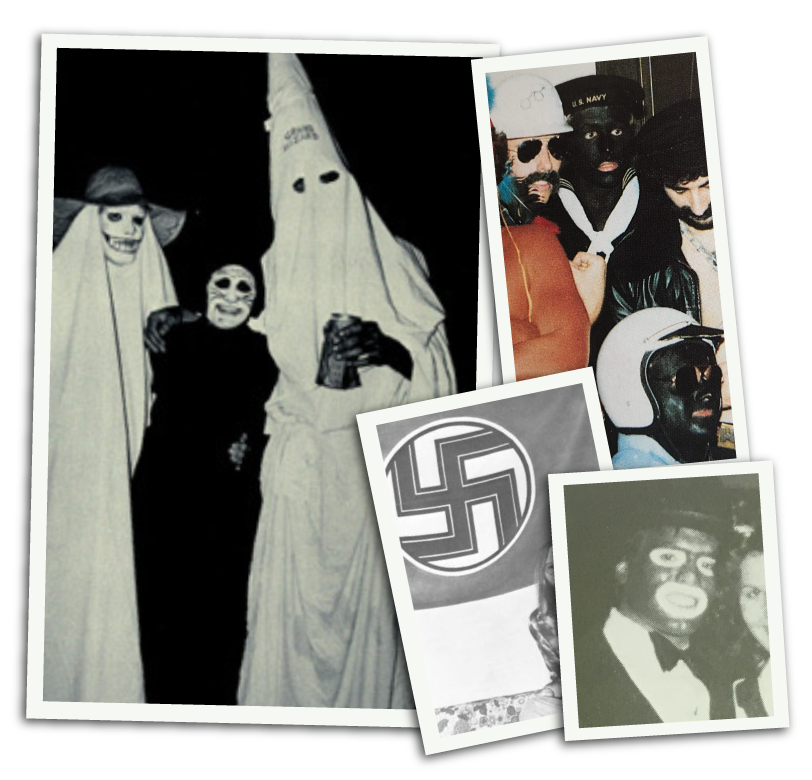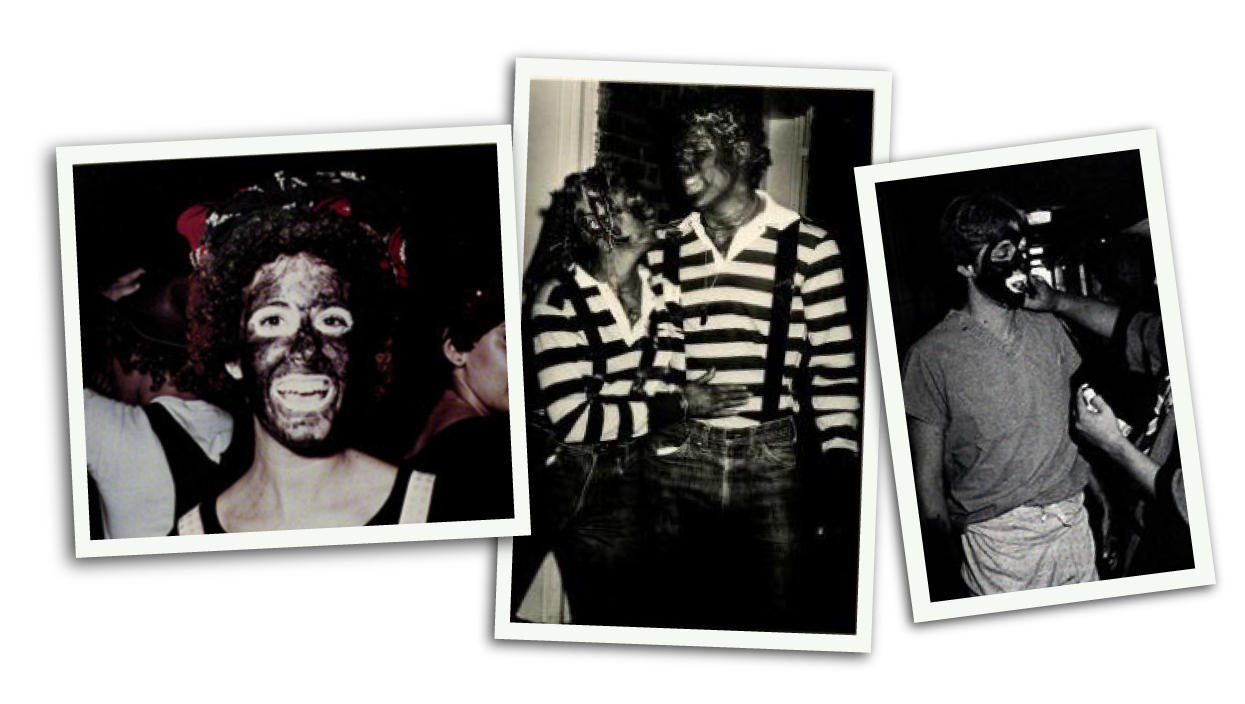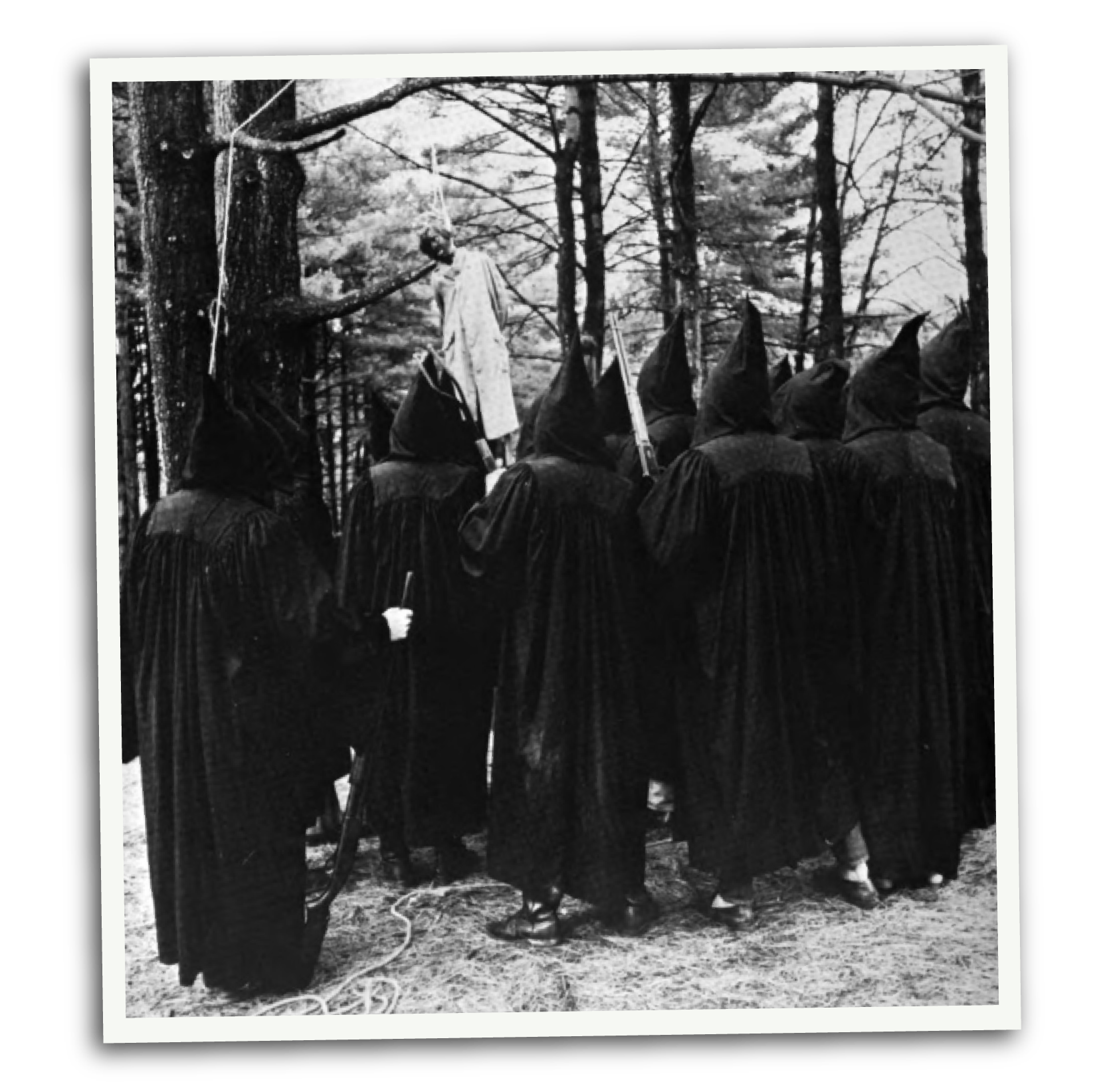People Dressed in White Hoods and Suits Due to Racism
The old yearbook photos capture the lighthearted moments from college worth remembering – smiling faces, pep rallies and cans of cheap beer.
But tucked in and among those same pages are pictures of students dressed in Ku Klux Klan robes and blackface, nooses and mock lynchings, displays of racism not hidden but memorialized as jokes to laugh about later.
Throughout the 1970s and 1980s, a stunning number of colleges and university yearbooks published images of blatant racism on campus, the USA TODAY Network found in a review of 900 publications at 120 schools across the country.
At Cornell University in New York, three fraternity members are listed in the 1980 yearbook as "Ku," "Klux" and "Klan." For their 1971 yearbook picture, a dozen University of Virginia fraternity members, some armed, wore dark cloaks and hoods while peering up at a lynched mannequin in blackface. In one of the most striking images – from the 1981 University of Illinois at Urbana-Champaign yearbook – a black man is smiling and holding a beer while posing with three people in full KKK regalia.
Reporters collected more than 200 examples of offensive or racist material at colleges in 25 states, from large public universities in the South, to Ivy League schools in the Northeast, liberal arts boutiques and Division I powerhouses.
STORY BEHIND THE STORY: How — and why — we reviewed 900 yearbooks
The yearbook photos reflect campus communities that tolerated open displays of racism at the parties they attended, parades they marched in and posters they hung – despite the hard-learned lessons of the civil rights movement they grew up with. In almost every picture, people appear happy.
Minority students from that era say the comfort with public behavior that would likely meet swift condemnation today further marginalized minorities on campus. And the choice to publish the images for posterity cut even deeper.
Cassandra Thomas, a black student at the University of Texas in the late 1970s, remembers seeing the photograph of someone wearing a KKK costume draped in a Confederate flag in her yearbook. But she felt she had no recourse on a campus where an almost all-white student body and administration decided what was acceptable and what wasn't.
"It was about keeping your head down," said Thomas, 60. "We were trying to get our degree and get out with the least amount of trouble."
The volume of shocking imagery found in the examination, which was not comprehensive, suggests that there are likely more yearbooks that recorded racism on campuses nationwide – and countless more acts never captured on camera or submitted for publication.
The review also gives new perspective to an array of cases that have emerged since reports showed that Virginia Gov. Ralph Northam's 1984 medical school yearbook page features a person wearing blackface and another in a KKK hood. The image, uncovered in early February, has endangered Northam's career and galvanized student newspapers and local outlets around the country to dig up other cases of politicians in racist situations.
No politicians were identified by USA TODAY Network's review, which focused on the same time period as Northam's yearbook, in the era after sweeping civil rights reform. Few images had captions to provide names or context and people's faces were often hidden behind hoods or blackface.
In one yearbook, from Arizona State University, reporters discovered that USA TODAY Editor Nicole Carroll had designed a page that included a photo of two people, at a fraternity's Halloween party, in black makeup as actress Robin Givens and boxer Mike Tyson. Carroll, who was editor of the yearbook in 1989 when the photo ran, expressed regret after learning of the photo.
EDITOR'S COLUMN: I became part of our story on racist images. I'm here to apologize for publishing that
FROM ARIZONA: More on the yearbook
"I was shocked when a colleague told me of my role in publishing a racist and hurtful photo in my college yearbook," Carroll said in a statement. "I am truly sorry for the harm my ignorance caused then, and the hurt it will cause now, 30 years later."

Experts say that even if school officials don't have direct oversight over the yearbooks, responsibility rests with the entire institution: A campus culture that fostered racist behavior; yearbook staffs that chose to memorialize it; and administrations that failed to condemn the images when they were published for the world to see.
Andre M. Perry, a David M. Rubenstein Fellow in the Metropolitan Policy Program at the Brookings Institution, has studied his alma mater's yearbooks at the University of Maryland. He said racism in higher education has a way of involving everyone on campus, so he wasn't surprised to see it documented so regularly.
"The way to fit in, sadly, is to make fun of black people," Perry said. "It's a unifying act. It's sad but racism pulls people, particularly white people, together."
The yearbooks in the USA TODAY Network examination also show students saluting in Nazi uniforms on Halloween or wearing orange paint and a headdress to depict a stereotype of a Native American on game day. There are "slave sale" fundraisers that auctioned off young women, "plantation parties" and a "sharecroppers ball." One picture shows a swastika banner hung up on what appears to be a dormitory wall.
But the vast majority of the offensive material show racist imagery, such as students in blackface or KKK robes, sometimes just pages away or even alongside images of minority students and university leaders.
BLACKFACE: What it means and why it won't go away
Read more: Virginia Gov. Ralph Northam slammed for referring to 'first indentured servants from Africa' instead of slaves
Since the Northam news broke, Steve LaCarter, 64, said he has been waiting for a phone call about the party he and his fraternity friends threw at the University of South Carolina in the 1976 school year. They put shoe polish on their faces, wore matching pink suits and lip synced soul music on stage. Someone took a picture, which he said he keeps in a bible at home along with other old photographs.
"I don't feel like I harmed anybody," he said. "There were no black people in the room watching that."
But he didn't know the yearbook had published it, which seemed to recalibrate his position.
"I can see that, for black people, even in the '70s, seeing that in the University of South Carolina yearbook, that's not right," he said. "But I didn't think about that. I didn't think about it."
Similar scenes are splashed across the yearbooks: There are white people dressed up as Michael Jackson, Tina Turner and Aunt Jemima for skits. A "sleazy pimp" in blackface at a fraternity's "Pimps and Whores" party. Some students painted their face like 19th-century minstrel shows. Others marched in parades wearing blackface. Groups of friends put on KKK robes for costume parties and Halloween.
"If you dress like that for Halloween and you knock on the door of a black family, how would they perceive your costume?" said Mia Moody-Ramirez, a professor at Baylor University who researches depictions of race and gender in the media. "Would you still feel as comfortable if you're in the company of African-Americans and you're wearing blackface?"
As more offensive images surface from yearbooks, Americans are trying to weigh how to reckon past actions with today's cultural norms, sharpened by more empowered minorities and social consciousness.

Experts said this is an opportunity for colleges not only to address the past, but also to focus on the racial inequalities that are still present on campus, just better hidden and more readily cast as separate from the school.
"It's easy to forbid things when you know they're going on behind closed doors," Perry said.
Hilary O. Shelton, director of the NAACP's Washington Bureau, said there is likely a range of intentions behind all of the photographs. The students in blackface dressing up for Halloween as a favorite black celebrity may have been trying to be funny and were just insensitive or oblivious to the harm they caused. The ones in KKK robes, or those who used blackface in a mocking way, might have worse motivations.
"They can argue they were ignorant to it, but it was still racist," Shelton said. The more meaningful distinction is how those same people respond in retrospect – whether they accept responsibility and apologize or deny having done something wrong.
"That's the bigger problem," said Shelton. "Ignorant arrogance, which is a very dangerous thing."
"How does that get into the yearbook?"
USA TODAY Network reached out to each university and fraternity named in this story where reporters found offensive pictures in yearbooks.
Nearly every president or spokesperson condemned the images as antithetical to school values and said they've taken steps over the years to become more inclusive, distancing themselves from the past while also acknowledging history's stain on the campus.
"Many of these photos are extremely offensive and painful to view," Jim Ryan, president of the University of Virginia, said in a statement. "But while the photos themselves are shocking, their existence is not."

But experts say schools have a long way to go to solve disparities still entrenched in higher education today.
"The patterns of behavior in place in 1975 are not perhaps that different," said psychologist Beverly Daniel Tatum, a former Spelman College president who graduated from Wesleyan University that year and has since written several books about racism in education.
Some universities, including American, Elon and Wake Forest, released findings from their own internal reviews to identify offensive images in past yearbooks.
On the New York school's 150th anniversary in 1979, the Rochester Institute of Technology yearbook published a photo of nine students in KKK robes, one holding a noose. The photo is grainy, which makes it difficult to know for certain, but posing with them is either a white student in blackface or a black student.
The school blocked access to its digital archive on the web after receiving inquiries from a reporter.
"We find the photos highly offensive and not reflective of today's RIT," spokeswoman Ellen Rosen explained in an email, "so we did not want them easily shared."
Tom Grotta, who now owns and curates a contemporary art gallery with his wife, was the editor of the RIT yearbook in 1979. He said the school was a progressive campus with little racial tension and that he did not remember including the photograph.
After viewing the photo, which shares a page with photos from a Halloween party, Grotta suspected that the students had just acted in a play because of the canvas wall behind them. Like the vast majority of the images reviewed by USA TODAY, it has no caption and very little context outside of other photos around it.
"I don't regret the picture," Grotta said. "I regret not having a caption."
At Cornell, the Sigma Nu fraternity submitted KKK and Nazi references instead of the members' names for captions in their 1980 yearbook photo.

Three former fraternity members at the time, including two who are Jewish, said they hadn't seen the yearbook page until a USA TODAY reporter emailed it to them. Both said they never felt hostility from peers at the fraternity – even if some were less welcoming than others – but were stunned to learn what had been published.
"I lived in the house with all these guys," said Eric Babat, a freshman at the time and now an attorney in New York. "How does that get into the yearbook without somebody flagging it? I don't understand. This was in the Cornell yearbook?"
Sigma Nu spokesman Drew Logsdon denounced the "deeply offensive images" in a statement.
After publication, Martha Pollack, the president of Cornell University, denounced the captions. A spokesman for the university had initially declined to comment.
A Tradition of Racism
Though many colleges began prohibiting Confederate flag displays on campus decades ago, Confederate imagery remains a part of the fabric at some schools in the South.
For generations, the Kappa Alpha Order fraternity at schools across the South, including the University of South Carolina and Auburn University, maintained traditions of the "Old South" with parades and parties in Confederate clothing and flags, some the size of a basketball court, all recorded in dozens of yearbooks.
The fraternity has since banned the display of the flags, and in 2010 prohibited members from wearing Confederate uniforms at events. Kappa Alpha Order spokesman Jesse S. Lyons said in a statement that the racist acts documented at fraternity parties "are not appropriate at any time, do not reflect who we are, and would not be tolerated."
Read More: In blackface controversy, Virginia remains haunted by its Confederate past
At the University of Texas, prejudice at the school was so acute and institutionalized that some professors lectured about black inferiority in the classrooms, former student Cassandra Thomas recalled.
Thomas shared another moment that stung: Her white roommate freshman year moved out immediately after discovering she had been paired with a black student. She said she could go a whole day without seeing another person of color.
"We weren't trying to change the world then the way we would do it today," Thomas said.
While southern schools may be the crucible for racist customs, the photos captured by the USA TODAY review show they extend to other parts of the country as well.
In schools across the Midwest and North, campuses often touted as bastions of liberalism and tolerance, yearbooks chronicle some of the same displays.
Until 1969, the University of Vermont celebrated a "Kake Walk" festival that featured white students who dressed in blackface as an homage to minstrel shows. But references to it, including blackface, emerged in the yearbooks in the following decades.
Minstrel shows had helped perpetuate negative stereotypes about black people – who weren't allowed to play themselves – before the growing black political and social power of the civil rights movement squashed it from popular culture in the 1960s.
Experts say those same sort of displays can show the extreme power structures on campuses today, where the pressure to conform and protect yourself often outweighs your sense of injustice.
"People ask, 'Why are the black kids sitting together in the cafeteria?'" said Beverly Daniel Tatum, the psychologist and author. "It's because they are protecting themselves from this kind of toxic environment."
Reporters found five examples of black students appearing in or alongside KKK robes, including the 1981 Illinois photograph from a Halloween party.
"As a black or brown student, you have to navigate those social relationships: Try to fit in or get punished by that same social structure?" said Andre M. Perry at the Brookings Institution. "Many students just grin and bear it. They know deep down this is wrong; they're making fun of people like me."
Jeffrey Barkstall, 57, was one of few black students who attended Illinois at the time the yearbook published the picture of a black man, who is not identified, posing with three individuals hidden by KKK outfits.
"I'm sure at the time they probably thought that was funny," said Barkstall, now a realtor in Illinois.
He paused for a moment to consider his time at college almost 40 years ago and whether he might have known who was behind the Klan hoods.
"Who knows?" he said. "There may be senators under those masks."
With contributions from: Elisha Anderson, David Andreatta, Rachel Axon, Clairissa Baker, Dave Bangert, Megan Banta, John Barry, Natasha Blakely, Bonnie Bolden, Giacomo Bologna, Anthony Borrelli, Katie Sullivan Borrelli, Matt Brannon, Mary Chao, Trish Choate, Ellen Ciurczak, Mark Curnutte, Nicole Higgins DeSmet, Michael Diamond, Will DiGravio, Byron Dobson, Bob Dohr, Alana Edgin, Allison Ehrlich, Rilyn Eischens, Kirsten Fiscus, Maggie Gilroy, Jason Gonzales, Emily Havens, Holly Hays, Samantha Hernandez, Brinley Hineman, Brandon Holveck, Tyler Horka, Stephanie Ingersoll, Kyle Jones, Sara Karnes, Monica Kast, Corinne Kennedy, Cameron Knight, Rachel Leingang, Dann Miller, Trevor Mitchell, Justin Murphy, Amanda Oglesby, Tovah Olson, Darrin Peschka, Dan Radel, Gege Reed, Mike Reicher, Gus Garcia-Roberts, Peggy Santoro, Jeff Schwaner, Caryn Shaffer, Devi Shastri, Svetlana Shkolnikova, Georgie Silvarole, Mollie Simon, Seth Slabaugh, Nichelle Smith, Zachary Smith, Matt Steecker, Joe Szydlowski, Sarah Taddeo, Jason Truitt, Natasha Vaughn, Rose Velazquez, Katie Wadington, Tom Whitehurst Jr. and Candy Woodall
Source: https://www.usatoday.com/in-depth/news/investigations/2019/02/20/blackface-racist-photos-yearbooks-colleges-kkk-lynching-mockery-fraternities-black-70-s-80-s/2858921002/

0 Response to "People Dressed in White Hoods and Suits Due to Racism"
Post a Comment